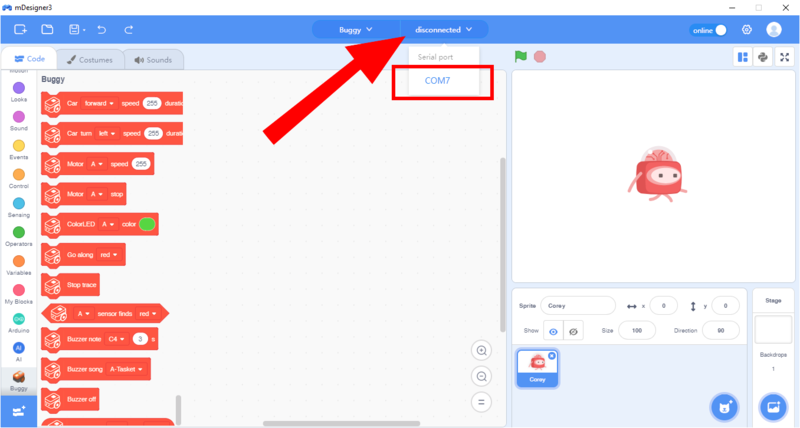Difference between revisions of "Itty Bitty Buggy: Getting Started (mDesigner)"
(→mDesigner's User Interface) |
(→mDesigner's User Interface) |
||
| Line 31: | Line 31: | ||
Here is a quick overview of mDesigner's User Interface. A more in-depth description can be found [[no_link|'''here''']]. | Here is a quick overview of mDesigner's User Interface. A more in-depth description can be found [[no_link|'''here''']]. | ||
|} | |} | ||
| − | [[File:MDesigner_v1.6_Live_Mode_UI.png | + | [[File:MDesigner_v1.6_Live_Mode_UI.png]] |
=Configuring mDesigner for Itty Bitty Buggy= | =Configuring mDesigner for Itty Bitty Buggy= | ||
Revision as of 01:13, 2 November 2018
| mDesigner software installation must be completed before proceeding to this guide.
The mDesigner software installation guide can be found here for Windows / for Mac |
This tutorial will get you getting started with programming Itty Bitty Buggy with mDesigner.
The following topics will be covered:
- Hardware preparation
- Overview of mDesigner's user interface.
- Configuring mDesigner for use with Itty Bitty Buggy.
- Assembling code blocks (creating a program)
- Online vs. Offline Mode
Contents
Hardware Preparation
|
Assemble Itty Bitty Buggy into it's default Buggy mode with mCenter+ on top of Buggy Base. Ensure the cable is connected to pin D2/D3 on mCenter+ and the other end connected to to Buggy Base. Attached the wheels onto Buggy Base. This hardware configuration will be used in the remaining tutorials. |
|
Connect the USB cable to Buggy and the other end to your computer's USB port. Switch on Buggy with the power switch. |
mDesigner's User Interface
|
Here is a quick overview of mDesigner's User Interface. A more in-depth description can be found here. |
Configuring mDesigner for Itty Bitty Buggy
|
Under the kit selection, select Buggy. |
|
This allows access to the Buggy control blocks. |
Connecting to Itty Bitty Buggy to mDesigner (Online mode)
|
Ensure Itty Bitty Buggy is connected to your computer with the USB cable and powered on. |
|
Ensure mDesigner is in Online mode. (If mDesigner is in Offline mode, click on the slider to switch it to Online mode.) |
|
Click on the Port Selector. This will list serial devices connected to your computer. |
| Windows | Mac OS |
|---|---|
| Port will be listed as COM__ (w/ a number). | Port will be listed as /dev/tty.SLAB_USBtoUART |
|
Click to select the port. The text box will now change from disconnected to connected (or ready). |
|
Note: If you do not see any ports or similar ports, please check if Itty Bitty Buggy is connected to your computer and turned on. |
|
A special program needs to be uploaded onto Itty Bitty Buggy in order to use it with mDesigner in Online mode. |
|
An upload dialog will appear and Upload Completed will appear when done. Click OK to close the dialog. |
|
The Connected text will now change to Ready. |
|
Note: The text on the port selector determines the current status of Buggy's connectivity to your computer.
|
|
Itty Bitty Buggy is now connected and ready to be programmed in mDesigner! |
Assembling A Program
To create a program in mDesigner. Simply drag blocks from the Blocks section into the Script section.
First Example
|
Clicking on a Block Category such as Events or Buggy will bring up the Blocks in that category. This allows you to quickly find the Blocks you need. |
|
For this example, first click on Events under the Block Categories section.
Then drag the |
|
Next, click on the Buggy category. |
|
Now, change the color on the |
|
Click anywhere on the assembled code Blocks to run it. |
|
After activating the code Blocks, ColorLED "A" on Itty Bitty Buggy will turn on! |
|
Select a different color, and activate the code Blocks again. What happens? |
"Online" vs. "Offline" modes
|
mDesigner can operate in two different modes: "Online" and "Offline" modes. In the example above, "Online" mode was demonstrated. |
mDesigner can interact with Itty Bitty Buggy in two different modes. Each mode has its own pros and cons. It is recommended to use Online mode initially before exploring Offline mode.
Online mode is Scratch, but with added blocks which are designed to interact with Itty Bitty Buggy and Microduino modules. This means the user has access to the stage and actor blocks. Projects (hardware, such as Itty Bitty Buggy) need to be connected to the computer running mDesigner. mDesigner communicates with the project (hardware), namely the Core+ module (embedded inside mCenter+), in "real time" over the USB connection by sending commands for the Core+ module to perform. This means that "Online" mode requires a constant connection with the computer running mDesigner.
Offline mode acts as a "visual" drag and drop coding editor. The script (code) is converted to "Arduino" (text code) code and then compile and uploaded to the attached the Core+ module (embedded inside mCenter+). This means that code can run even when detached from the computer. The stage and actor are disabled in this mode since the code runs independent of mDesigner.
| Capability | Online Mode | Offline Mode |
|---|---|---|
| Drag & Drop programming | Yes | Yes |
| Supports Microduino modules | Yes | Yes |
| Stage and actor enabled | Yes | No |
| Real time code testing | Yes | No |
| Code compiled and uploaded | No | Yes |
| Can run WITHOUT being connect to computer | No | Yes |


















